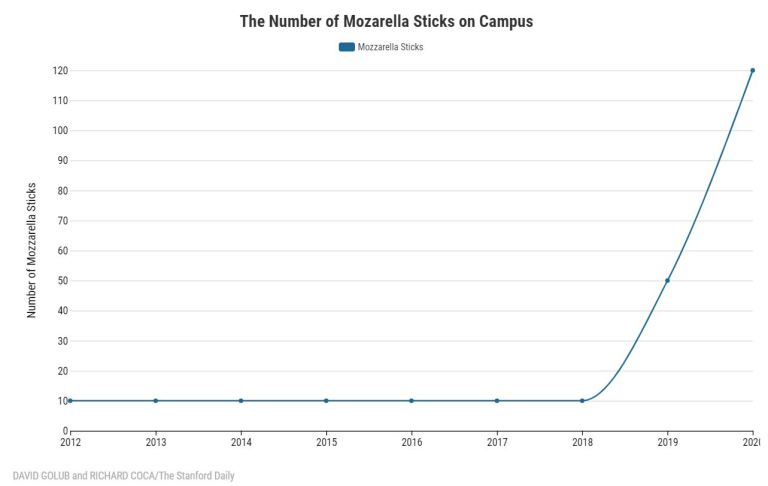In this time of uncertainty, we at The Stanford Occasionally wanted to take a step back and look at some of the more interesting changes that took place over the previous decade. Stanford in the 2010s is a series featuring data visualizations started by The Stanford Daily Data Team on how things changed (or did not change) in the University community.
We, at The Occasionally, also wanted to capitalize on all the cool graphics our data team can make, which culminated in this project.
Mozzarella sticks in the 2010s
Over the past decade, the Associated Students of Stanford University (ASSU) has advocated and changed the Stanford experience for thousands of students Take mozzarella sticks, for example. Before 2019, mozzarella sticks were offered only at Late Nite at Arrillaga Family Dining Commons and Lakeside Dining. Thanks to former ASSU Senators Jon Johnson, and Matthew Wigler, this changed when The Axe and Palm (TAP) responded to a formal Senate resolution requesting mozzarella sticks be offered at the establishment. TAP even formally announced its decision on its Facebook page, which we consider a pretty big deal.
It’s also the reason why we at The Occasionally have seen a spike in the number of mozzarella sticks on campus.
Caterpillars on campus in the 2010s
Throughout the 2010s, Stanford has seen interesting trends between the number of caterpillars on campus versus in nightmares. Stanford experiences outbreaks of Oak Moth Caterpillars and Tussock Moth Caterpillars from time to time — but they’ve increased in recent years. Dangling from the Oak trees around campus, these caterpillars are extremely damaging to the trees. The hairs of these caterpillars also cause skin irritation in sensitive individuals, so it’s no surprise they appear in Stanford students’ nightmares. Trends show, however, that as MATH 51 midterms begin to dominate students’ nightmares, the number of caterpillars has had virtually no effect on the number of caterpillars in nightmares. Instead, even as caterpillars have started to thrive, fewer students have dreamed of them.
Trends in Meyer Green
Few students realize that prior to Meyer Green, Meyer Library existed and was loved by many alums. Few alumni, however, have yet to realize that few current students care. The number of times I personally have had alumni complain to me about how they didn’t have a green space could warrant its own data visualization.
Skunk sprayings
For those students who are not on campus, The Stanford Occasionally would like to inform you that skunks have replaced you. Whereas students once went to dining halls to have lunch and catch up with friends, skunks have begun their plan for world domination. We at The Occasionally were surprised at the sheer number of skunks currently roaming on campus. Where they live when students are on campus remains a mystery.
Editor’s Note: This article is purely satirical and fictitious. All attributions in this article are not genuine and this story should be read in the context of pure entertainment only.
Contact Richard Coca at rich ‘at’ stanford.edu and David Golub at golubd ‘at’ stanford.edu or The Stanford Daily Data Team at data ‘at’ stanforddaily.com.
